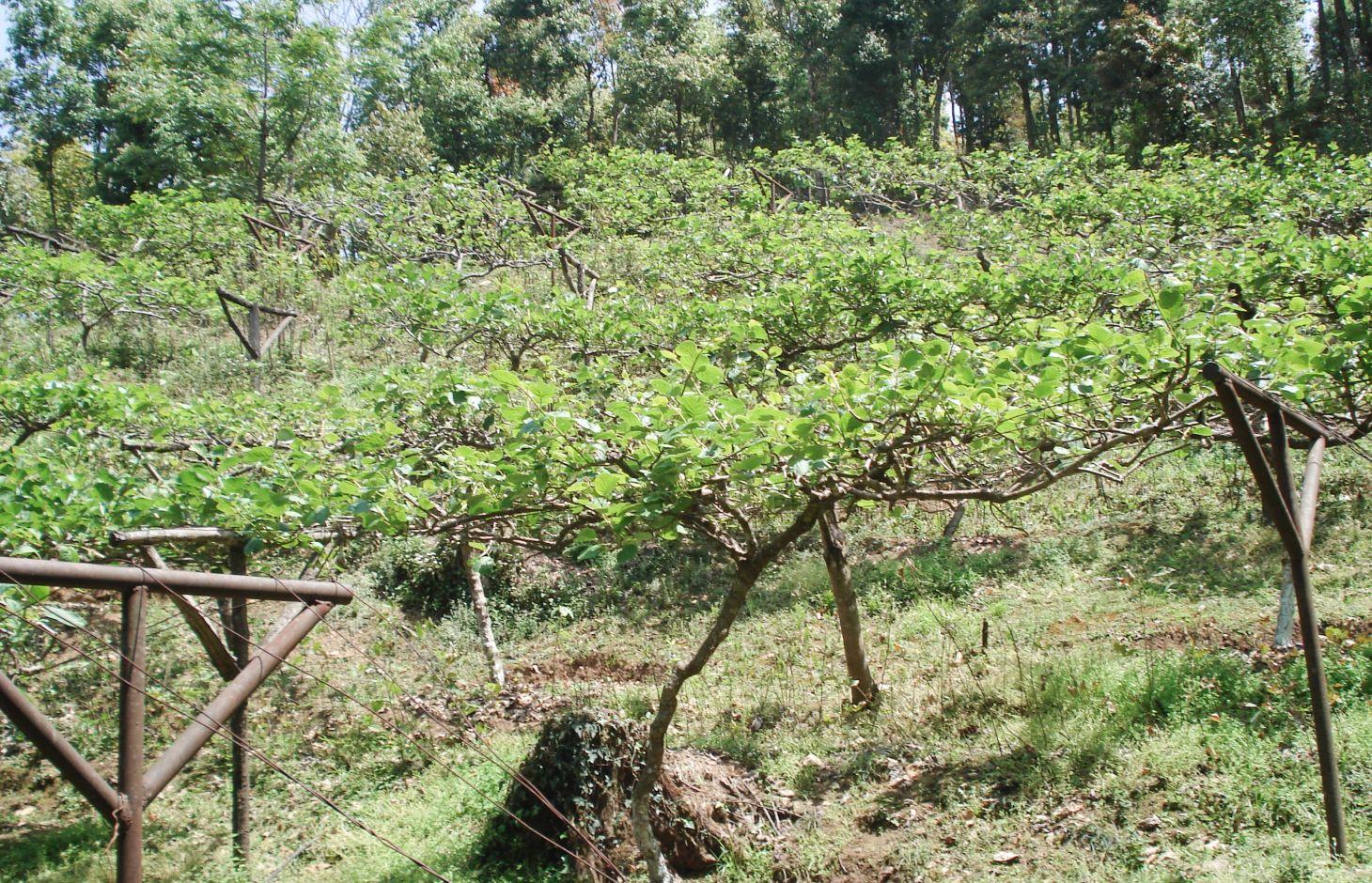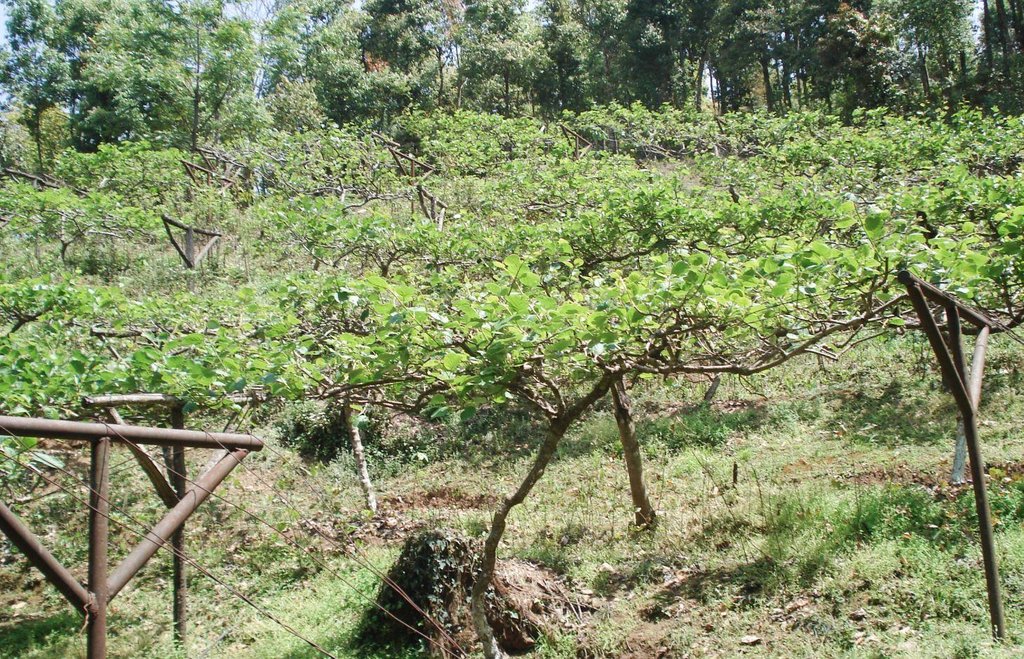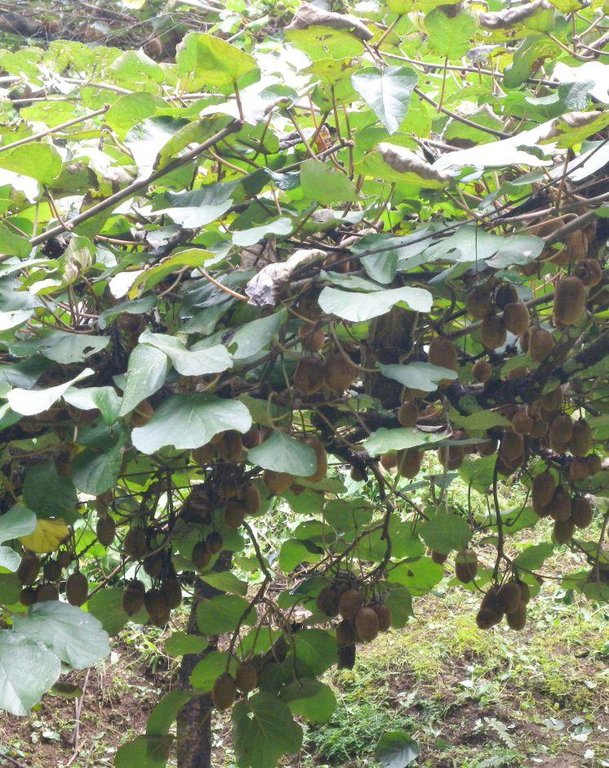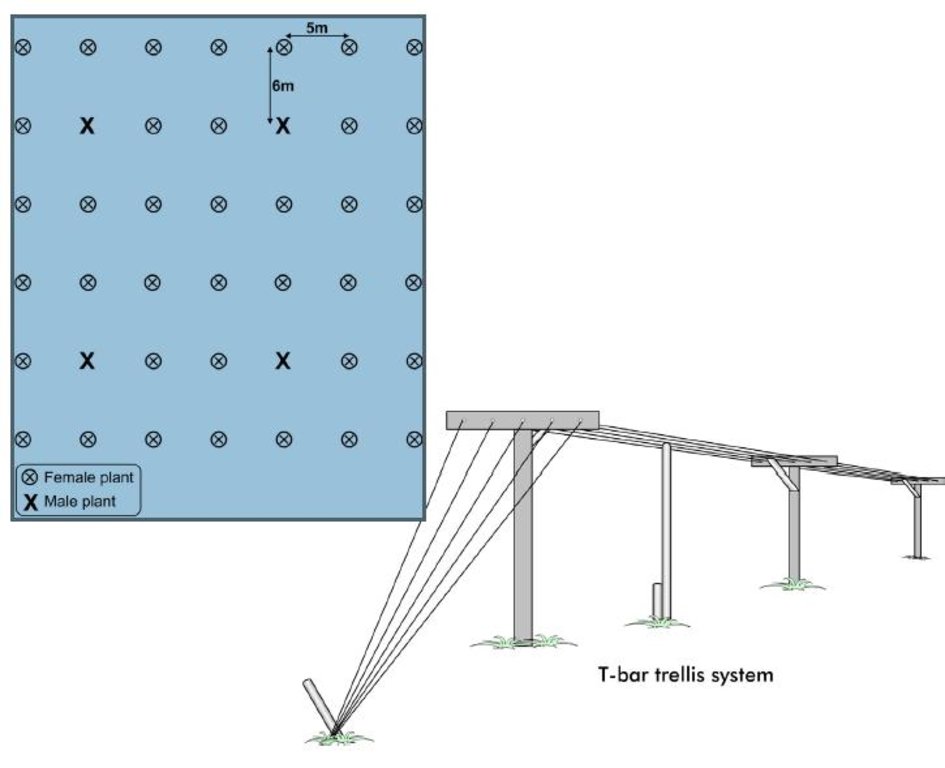Kiwi fruit cultivation [尼泊尔]
- 创建:
- 更新:
- 编制者: Shreedip Sigdel
- 编辑者: –
- 审查者: David Streiff
kiwi (theki) fal kheti (Main Contributor: Samden Sherpa, ICIMOD)
technologies_1686 - 尼泊尔
查看章节
全部展开 全部收起1. 一般信息
1.2 参与该技术评估和文件编制的资源人员和机构的联系方式
SLM专业人员:
Sherpa Samden Lama
+977 1 5003222
ssherpa@icimod.org
ICIMOD
P.O.Box 3226, Kathmandu, Nepal
尼泊尔
有助于对技术进行记录/评估的机构名称(如相关)
ICIMOD International Centre for Integrated Mountain Development (ICIMOD) - 尼泊尔1.3 关于使用通过WOCAT记录的数据的条件
(现场)数据是什么时候汇编的?:
01/04/2011
编制者和关键资源人员接受有关使用通过WOCAT记录数据的条件。:
是
2. SLM技术的说明
2.1 技术简介
技术定义:
Kiwi fruit cultivation on sloping land in the mid-hill areas of Nepal can help prevent soil erosion and is a sustainable land management practice. This high value crop introduces biodiversity and improves livelihoods by providing a source of cash income.
2.2 技术的详细说明
说明:
The kiwi fruit is native to China. Previously called Chinese gooseberry, it is now more commonly known by its marketing name of kiwi fruit. Kiwi fruits grow on large vines that are similar to grapevines in their general growth and fruiting habits as well as their training and trellising requirements. The fruit normally ripens within 25 weeks after the flowers first appear. The fruits range in weight from 40 to 90 g and can be picked shortly after the first frost in autumn; after that, they can be kept in cold storage for 4–6 months at oC. Kiwi vines can be grown on a wide range of soil types at elevations ranging from 1000 m to 2500 m. The kiwi plant is dioecious, meaning individual plants are either male or female. Only female plants bear fruit, but only when pollinated by a male plant. Vines of both sexes are essential for fruit production, and they must flower at the same time to ensure pollination. One male pollinator vine is required for eight female vines. The vines are commonly supported on sturdy structures strong enough to bear the heavy fruit, which might otherwise break the rather weak vines. T-bars or hitching post trellises are recommended to support the large fruiting area in the form of a canopy and provide easy access to the fruit.
Establishment / maintenance activities and inputs: Seedlings can be planted in the spring as soon as there is little chance of frost. Vines need to be pruned both in summer and in winter to maintain a balance between kiwi plant growth and profitable fruit production. Excessive plant growth is removed during the growing season to keep the kiwi canopy open and to remove non-fruiting wood. Harvesting can begin from the end of November. Frequent weeding is required to reduce competition for moisture and fertilizer. Kiwi fruit requires abundant water; during the dry season the newly planted kiwi vines need deep watering once a week.
2.3 技术照片
2.5 已应用该技术的、本评估所涵盖的国家/地区/地点
国家:
尼泊尔
有关地点的进一步说明:
Lalitpur District
2.7 技术介绍
详细说明该技术是如何引入的:
- 在实验/研究期间
3. SLM技术的分类
3.1 该技术的主要目的
- 减少、预防、恢复土地退化
- 创造有益的经济影响
3.2 应用该技术的当前土地利用类型

农田
- 多年一作(非木材)
注释:
Major land use problems (compiler’s opinion): When sloping land is not used for agricultural production and not planted with ground cover or other vegetation (such as contour hedgerows), the fertile soil can be eroded and washed away by heavy monsoon rains.
3.3 有关土地利用的更多信息
每年的生长季节数:
- 2
3.4 该技术所属的SLM组
- 改良植物品种/动物品种
3.5 技术传播
注释:
Total area covered by the SLM Technology is 0.01 m2.
3.6 包含该技术的可持续土地管理措施

植物措施
- V1:乔木和灌木覆盖层
3.7 该技术强调的主要土地退化类型

土壤水蚀
- Wt:表土流失/地表侵蚀

化学性土壤退化
- Cn:肥力下降和有机质含量下降(非侵蚀所致)
注释:
Main causes of degradation: deforestation / removal of natural vegetation (incl. forest fires)
3.8 防止、减少或恢复土地退化
具体数量名该技术与土地退化有关的目标:
- 减少土地退化
4. 技术规范、实施活动、投入和成本
4.1 该技术的技术图纸
4.2 技术规范/技术图纸说明
Above: Layout of a kiwi orchard. The ideal density of kiwi plants in an orchard is 300 per ha, or in terms of the units of measure commonly used in Nepal, 15 plants per ropani. The plants are spaced 6 m apart and the distance between the rows is 5 m, with a male to female plant ratio of 1:8.
Below: T-bars are used as trellis supports for the kiwi vines. The T-bars are 2.5–3 m long iron posts that are anchored into the ground; they extend approximately 1.8 m above the ground and 60–70 cm deep into the soil. The arms of the T-bar extend 1–1.2 m. The bars are spaced approximately 4.5 m apart with galvanized wire strung between them and pulled taught to form the trellis itself. The end posts are braced by 4–5 wires that are secured into the ground (as shown).
The kiwi plants should be at least
0.6 m away from the T-bars. The centre wire supports the main cordons, and the outer wires support the fruiting lateral parts.
Technical knowledge required for field staff / advisors: moderate
Technical knowledge required for land users: moderate
Main technical functions: improvement of ground cover, increase of biomass (quantity), Reduce soil erosion
Secondary technical functions: control of concentrated runoff: impede / retard, reduction of slope angle
4.3 有关投入和成本计算的一般信息
具体说明成本和投入是如何计算的:
- 每个技术区域
注明尺寸和面积单位:
ha
具体说明成本计算所用货币:
- 美元
注明雇用劳工的每日平均工资成本:
3.7
4.4 技术建立活动
| 活动 | 措施类型 | 时间 | |
|---|---|---|---|
| 1. | • The plot where the vines are to be planted is prepared by clearing and weeding.• The seedling pits are prepared at least 2 months before planting. Typically the pits are 1 m x 1 m and 1 m deep. The pits are filled with compost (30 kg per pit ) and covered with soil to a height of 0.3 m above the ground. | 植物性的 | 2 months |
| 2. | • Seedlings are planted in the winter to the same depth as in the nursery; they are planted 6 m apart in rows spaced 5 m apart.• The plants are pruned back to single, healthy shoots 15–30 cm high. | 植物性的 |
4.5 技术建立所需要的费用和投入
| 对投入进行具体说明 | 单位 | 数量 | 单位成本 | 每项投入的总成本 | 土地使用者承担的成本% | |
|---|---|---|---|---|---|---|
| 劳动力 | Prepare pits and seedlings | persons/day/ha | 136.0 | 3.6765 | 500.0 | |
| 植物材料 | Planting material | ha | 1.0 | 1500.0 | 1500.0 | |
| 肥料和杀菌剂 | Compost / manure | ha | 1.0 | 150.0 | 150.0 | |
| 施工材料 | Iron pole | ha | 1.0 | 3500.0 | 3500.0 | |
| 技术建立所需总成本 | 5650.0 | |||||
4.6 维护/经常性活动
| 活动 | 措施类型 | 时间/频率 | |
|---|---|---|---|
| 1. | Permanent sod is maintained between the plant rows. Frequent weeding is required especially during the rainy season.• Both summer and winter pruning is required. | 植物性的 | |
| 2. | • Cuttings from branches that fruited during the previous season (typically less than a pencil width in thickness) are collected during the winter pruning for propagation.• Overhead sprinkler irrigation is used for commercial kiwi production.• Kiwi vines are fertilized with manure in the early spring | 植物性的 |
4.7 维护/经常性活动所需要的费用和投入(每年)
| 对投入进行具体说明 | 单位 | 数量 | 单位成本 | 每项投入的总成本 | 土地使用者承担的成本% | |
|---|---|---|---|---|---|---|
| 劳动力 | Maintenance and prunning | persons/day/ha | 122.0 | 3.6885 | 450.0 | |
| 设备 | Secateurs | ha | 1.0 | 50.0 | 50.0 | |
| 设备 | Binding wire | ha | 1.0 | 650.0 | 650.0 | |
| 肥料和杀菌剂 | Compost / manure | ha | 1.0 | 150.0 | 150.0 | |
| 技术维护所需总成本 | 1300.0 | |||||
4.8 影响成本的最重要因素
描述影响成本的最决定性因素:
The above establishment cost is for a plantation of 300 plants on one hectare; the recurrent annual maintenance cost has been calculated for a plantation of 300 plants per ha per year. All costs are estimated based on experience gained at the ICIMOD Knowledge Park at Godavari.
5. 自然和人文环境
5.1 气候
年降雨量
- < 250毫米
- 251-500毫米
- 501-750毫米
- 751-1,000毫米
- 1,001-1,500毫米
- 1,501-2,000毫米
- 2,001-3,000毫米
- 3,001-4,000毫米
- > 4,000毫米
农业气候带
- 半湿润
Thermal climate class: subtropics
5.2 地形
平均坡度:
- 水平(0-2%)
- 缓降(3-5%)
- 平缓(6-10%)
- 滚坡(11-15%)
- 崎岖(16-30%)
- 陡峭(31-60%)
- 非常陡峭(>60%)
地形:
- 高原/平原
- 山脊
- 山坡
- 山地斜坡
- 麓坡
- 谷底
垂直分布带:
- 0-100 m a.s.l.
- 101-500 m a.s.l.
- 501-1,000 m a.s.l.
- 1,001-1,500 m a.s.l.
- 1,501-2,000 m a.s.l.
- 2,001-2,500 m a.s.l.
- 2,501-3,000 m a.s.l.
- 3,001-4,000 m a.s.l.
- > 4,000 m a.s.l.
5.3 土壤
平均土层深度:
- 非常浅(0-20厘米)
- 浅(21-50厘米)
- 中等深度(51-80厘米)
- 深(81-120厘米)
- 非常深(> 120厘米)
土壤质地(表土):
- 中粒(壤土、粉土)
表土有机质:
- 高(>3%)
如有可能,附上完整的土壤描述或具体说明可用的信息,例如土壤类型、土壤酸碱度、阳离子交换能力、氮、盐度等。:
Soil fertility is medium
Soil drainage / infiltration is medium
Soil water storage capacity is medium
5.4 水资源可用性和质量
地下水位表:
< 5米
地表水的可用性:
好
水质(未处理):
良好饮用水
关于水质和水量的注释和进一步规范:
Water quality (untreated): Also for agricultural use (irrigation)
5.5 生物多样性
物种多样性:
- 高
关于生物多样性的注释和进一步规范:
695 species of flora and 230 species of fauna have been documented within the Knowledge Park's 30 ha area
5.6 应用该技术的土地使用者的特征
生产系统的市场定位:
- 混合(生计/商业
非农收入:
- > 收入的50%
机械化水平:
- 手工作业
- 畜力牵引
说明土地使用者的其他有关特征:
Population density: < 10 persons/km2
5.7 应用该技术的土地使用者拥有或租用的平均土地面积
- < 0.5 公顷
- 0.5-1 公顷
- 1-2 公顷
- 2-5公顷
- 5-15公顷
- 15-50公顷
- 50-100公顷
- 100-500公顷
- 500-1,000公顷
- 1,000-10,000公顷
- > 10,000公顷
5.8 土地所有权、土地使用权和水使用权
土地所有权:
- 州
土地使用权:
- 社区(有组织)
- 个人
用水权:
- 社区(有组织)
- 个人
5.9 进入服务和基础设施的通道
道路和交通:
- 贫瘠
- 适度的
- 好
Labour:
- 贫瘠
- 适度的
- 好
6. 影响和结论性说明
6.1 该技术的现场影响
社会经济效应
水资源可用性和质量
灌溉用水需求
社会文化影响
食品安全/自给自足
注释/具体说明:
Kiwi is considered an elite fruit and it is usually too expensive for local consumption
社区机构
SLM/土地退化知识
livelihood and human well-being
注释/具体说明:
Kiwi production can be a good source of cash income as it is a high value crop. Kiwi fruit is high in nutrients, eating kiwis has been show to boost the immune system, to help regulate blood pressure, and to be beneficial for cardiac patients
生态影响
土壤
土壤覆盖层
土壤流失
生物多样性:植被、动物
生物量/地上C
其它生态影响
Pollen for bees
biodiversity
efficient use of land
competition with other plants for water, nutrients, and sunlight when intercropping
6.2 该技术的场外影响已经显现
下游洪水
缓冲/过滤能力
6.3 技术对渐变气候以及与气候相关的极端情况/灾害的暴露和敏感性(土地使用者认为的极端情况/灾害)
气候有关的极端情况(灾害)
气象灾害
| 该技术是如何应对的? | |
|---|---|
| 局地暴雨 | 好 |
| 局地风暴 | 不好 |
气候灾害
| 该技术是如何应对的? | |
|---|---|
| 干旱 | 不好 |
其他气候相关的后果
其他气候相关的后果
| 该技术是如何应对的? | |
|---|---|
| Mild winter frost | 好 |
注释:
A net canopy can be used to protect the vines from hail storms and help prevent fruit from dropping prematurely
6.4 成本效益分析
技术收益与技术建立成本相比如何(从土地使用者的角度看)?
短期回报:
积极
长期回报:
非常积极
技术收益与技术维护成本/经常性成本相比如何(从土地使用者的角度看)?
短期回报:
稍微积极
长期回报:
非常积极
注释:
The approximate annual income from kiwi production is USD 11,765/ha/year. The technology provides on-farm employment opportunities for both men and women.
6.5 技术采用
- 单例/实验
注释:
There is a moderate trend towards spontaneous adoption of the Technology
Comments on adoption trend: Kiwi fruit is gaining in popularity in Nepal; at present it is cultivated commercially by farmers in Kavre, Lalitpur, Dolakha, and Ilam Districts as well as in the Kathmandu Valley. The technology is widely accepted. Kiwi saplings were initially supplied by ICIMOD and by a private nursery in Kavre District.
Driver for adoption:
• Increased market demand for kiwi fruit
• A good alternative for sloping land management
• Kiwi cultivation is a source of income generation
Constraints
• It has been difficult to meet the high demand for kiwi seedlings. The scarcity of seedlings is the main bottleneck limiting the uptake of kiwi production.
6.7 该技术的优点/长处/机会
| 编制者或其他关键资源人员认为的长处/优势/机会 |
|---|
|
Orchards are easy to establish and farmers can readily learn what is needed for kiwi cultivation How can they be sustained / enhanced? Awareness and training programmes can help farmers quickly learn what is needed for kiwi cultivation. |
|
The benefits of the technology are easy to observe; farmers generate cash income from selling kiwi fruit, juice, and jam. How can they be sustained / enhanced? Awareness and training programmes can help farmers quickly learn what is needed for kiwi cultivation and postharvest processing. |
|
Soil erosion is decreased due to increased groundcover. How can they be sustained / enhanced? Awareness and training programmes can help farmers quickly learn what is needed for kiwi cultivation. |
|
Kiwi cultivation provides on-farm employment opportunities. How can they be sustained / enhanced? Awareness and training programmes can help farmers quickly learn what is needed for kiwi cultivation. |
6.8 技术的弱点/缺点/风险及其克服方法
| 编制者或其他关键资源人员认为的弱点/缺点/风险 | 如何克服它们? |
|---|---|
| The initial costs associated with establishing the orchard may be a little expensive for many farmers, these include the purchase of: T-bar trellises, seedlings, iron rods, and wire. | Begin by using locally available materials such as bamboo poles to make T-bar trellis. |
7. 参考和链接
7.3 链接到网络上可用的相关信息
标题/说明:
Kiwi fruit production guide. Tuscaloosa, Alabama, United States: Alabama University, Himelrick, DG; Powell, A (1998)
URL:
http://www.aces.edu/pubs/docs/A/ANR-1084/ANR-1084.pdf
链接和模块
全部展开 全部收起链接
无链接
模块
无模块





